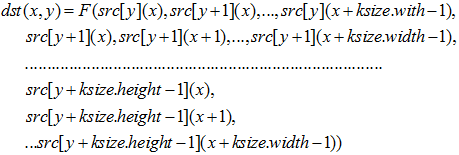【OpenCV】图像滤波 Image Filtering
来源:互联网 发布:淘宝唐朝品牌时装 编辑:程序博客网 时间:2024/05/21 13:08
译自《The OpenCV Reference Manual Release 2.3》
CHAPTER THREE: IMGPROC. IMAGE PROCESSING 3.1 Image Filtering
转载请注明出处:http://blog.csdn.net/xiaowei_cqu/article/details/7718831
本节描述对2D图像执行的各种线性和非线性的滤波操作。即用图像中每个像素点(x,y)临近的点进行运算。如果是线性滤波器,结果是每个像素值的加权和;如果是形态操作,结果是最小或最大值之类的。对每个坐标的像素操作的输出结果也在同一个坐标(x,y)处,这就意味着输出图像和输入图像有相同的大小。通常情况下,这些函数支持多通道图像,即对每个通道单独进行操作。因此,输出图像也与输入图像有相同的通道数。
本节描述的函数与类的另一个共同的特点是,不同于简单的算术运算,他们需要对一些不存在的像素值进行推测。例如,你想使用 3*3的高斯滤波器,处理图像每行最左侧的像素时还需要其左侧的像素,也就是图像外的像素。你可以让这些像素等于源图像最左侧的像素(“复制边(replicated border)”外推法),或者假设所有不存在的像素值为零(“恒量边(constant border)”外推法),等等。OpenCV允许你指定外推方法。详情请参阅 borderInterpolate()函数的功能及其参数描述。
BaseColumnFilter
单列核的基础滤波器。
class BaseColumnFilter{public:virtual ~BaseColumnFilter();// 用以被用户重写//// 对列的集合进行滤波操作// 输入"dstcount + ksize - 1" 行,输出"dstcount" 行,// 输入和输出的每行含有"width"个元素,// 滤波之后的行写入缓存"dst"中.virtual void operator()(const uchar** src, uchar* dst, int dststep,int dstcount, int width) = 0;// 重置滤波器的状态(IIR滤波器中可能用到)virtual void reset();int ksize; // 核的孔径int anchor; // 定位点坐标// 处理过程中一般不使用};类 BaseColumnFilter是使用单列核对数据滤波的基础类。滤波不一定是线性滤波,表示如下:
其中 F 是滤波函数,但是用类来表示,因为类可以有其他的,如储存之前处理的数据之类的附加功能。这个类只是定义一个接口并不直接使用。作为替代,OpenCV中有一些函数(你可以添加更多)实现了特定的滤波功能并返回指向派生类的指针。这些指针通过 FilterEngine构造函数。 虽然滤波操作接口使用uchar类型,具体实施时并限于8位数据。
BaseFilter
对2D图像滤波的基础类。
class BaseFilter{public:virtual ~BaseFilter();// 用以被用户重写//// 对列的集合进行滤波操作// 输入"dstcount + ksize.height - 1" 行,输出"dstcount" 行,// 输入的每行含有"(width + ksize.width-1)*cn"个元素// 输出的每行含有"width*cn"个元素,// 滤波之后的行写入缓存"dst"中.virtual void operator()(const uchar** src, uchar* dst, int dststep,int dstcount, int width, int cn) = 0;// 重置滤波器的状态(IIR滤波器中可能用到)virtual void reset();Size ksize;Point anchor;};类 BaseFilter 是使用2D核对数据滤波的基础类。滤波不一定是线性的,可以表示如下:
BaseRowFilter
单列核滤波器的基础类。
class BaseRowFilter{public:virtual ~BaseRowFilter();// 用以被用户重写//// 对输入的单列进行滤波操作// 输入列有 "width"个元素, 每个元素有 "cn" 个通道.// 滤波之后的行写入缓存"dst"中.virtual void operator()(const uchar* src, uchar* dst,int width, int cn) = 0;int ksize, anchor;};类 BaseRowFilter 是使用单列核对数据滤波的基础类。滤波不一定是线性的,可以表示如下:
其中 F 是滤波函数。此类只是定义了一个接口并不直接使用。这个类只是定义一个接口并不直接使用。作为替代,OpenCV中有一些函数(你可以添加更多)实现了特定的滤波功能并返回指向派生类的指针。这些指针通过 FilterEngine 构造函数。 虽然滤波操作接口使用uchar类型,具体实施时并限于8位数据。
FilterEngine
通用图像滤波类。
class FilterEngine{public:// 空的构造函数FilterEngine();// 构造2D的不可分的滤波器(!_filter2D.empty())或者// 可分的滤波器 (!_rowFilter.empty() && !_columnFilter.empty())// 输入数据类型为 "srcType", 输出类型为"dstType",// 中间的数据类型为 "bufType".// _rowBorderType 何 _columnBorderType 决定图像边界如何被外推扩充// 只有 _rowBorderType and/or _columnBorderType// == BORDER_CONSTANT 时 _borderValue 才会被用到FilterEngine(const Ptr<BaseFilter>& _filter2D,const Ptr<BaseRowFilter>& _rowFilter,const Ptr<BaseColumnFilter>& _columnFilter,int srcType, int dstType, int bufType,int _rowBorderType=BORDER_REPLICATE,int _columnBorderType=-1, // 默认使用 _rowBorderTypeconst Scalar& _borderValue=Scalar());virtual ~FilterEngine();// 初始引擎的分割函数void init(const Ptr<BaseFilter>& _filter2D,const Ptr<BaseRowFilter>& _rowFilter,const Ptr<BaseColumnFilter>& _columnFilter,int srcType, int dstType, int bufType,int _rowBorderType=BORDER_REPLICATE, int _columnBorderType=-1,const Scalar& _borderValue=Scalar());// 定义图像尺寸"wholeSize"为ROI开始滤波.// 返回图像开始的y-position坐标.virtual int start(Size wholeSize, Rect roi, int maxBufRows=-1);// 另一种需要图像的开始virtual int start(const Mat& src, const Rect& srcRoi=Rect(0,0,-1,-1),bool isolated=false, int maxBufRows=-1);// 处理源图像的另一部分// 从"src"到"dst"处理"srcCount" 行// 返回处理的行数virtual int proceed(const uchar* src, int srcStep, int srcCount,uchar* dst, int dstStep);// 处理整个ROI的高层调用virtual void apply( const Mat& src, Mat& dst,const Rect& srcRoi=Rect(0,0,-1,-1),Point dstOfs=Point(0,0),bool isolated=false);bool isSeparable() const { return filter2D.empty(); }// 输入图中未被处理的行数int remainingInputRows() const;// 输入中未被处理的行数int remainingOutputRows() const;// 源图的开始和结束行int startY, endY;// 指向滤波器的指针Ptr<BaseFilter> filter2D;Ptr<BaseRowFilter> rowFilter;Ptr<BaseColumnFilter> columnFilter;};类 FilterEngine 可以被用于对任何一个图像进行滤波。它包含了所有必要的缓冲区,计算需要的图像外的“虚”像素推算值等等。通过各种创建 *Filter 的函数(见下文)可以返回指向初始化的 FilterEngine 的实例,之后可以使用这些实例中的高层接口如 filter2D(), erode(),dilate() 等。因此,此类在OpenCV的很多滤波函数中起着关键的作用。 这个类使得滤波和其他函数结合更容易,如色彩空间转换,阈值,算术运算,等操作。将几个操作相结合在一起你可以得到更好的性能,因为数据都留在缓存中。例如以下是对浮点图像执行 Laplace 算子处理的简单例子,Laplacian() 函数可以简化为:
void laplace_f(const Mat& src, Mat& dst){CV_Assert( src.type() == CV_32F );dst.create(src.size(), src.type());// get the derivative and smooth kernels for d2I/dx2.// for d2I/dy2 consider using the same kernels, just swappedMat kd, ks;getSobelKernels( kd, ks, 2, 0, ksize, false, ktype );// process 10 source rows at onceint DELTA = std::min(10, src.rows);Ptr<FilterEngine> Fxx = createSeparableLinearFilter(src.type(),dst.type(), kd, ks, Point(-1,-1), 0, borderType, borderType, Scalar() );Ptr<FilterEngine> Fyy = createSeparableLinearFilter(src.type(),dst.type(), ks, kd, Point(-1,-1), 0, borderType, borderType, Scalar() );int y = Fxx->start(src), dsty = 0, dy = 0;Fyy->start(src);const uchar* sptr = src.data + y*src.step;// allocate the buffers for the spatial image derivatives;// the buffers need to have more than DELTA rows, because at the// last iteration the output may take max(kd.rows-1,ks.rows-1)// rows more than the input.Mat Ixx( DELTA + kd.rows - 1, src.cols, dst.type() );Mat Iyy( DELTA + kd.rows - 1, src.cols, dst.type() );// inside the loop always pass DELTA rows to the filter// (note that the "proceed" method takes care of possibe overflow, since// it was given the actual image height in the "start" method)// on output you can get:// * < DELTA rows (initial buffer accumulation stage)// * = DELTA rows (settled state in the middle)// * > DELTA rows (when the input image is over, generate// "virtual" rows using the border mode and filter them)// this variable number of output rows is dy.// dsty is the current output row.// sptr is the pointer to the first input row in the portion to processfor( ; dsty < dst.rows; sptr += DELTA*src.step, dsty += dy ){Fxx->proceed( sptr, (int)src.step, DELTA, Ixx.data, (int)Ixx.step );dy = Fyy->proceed( sptr, (int)src.step, DELTA, d2y.data, (int)Iyy.step );if( dy > 0 ){Mat dstripe = dst.rowRange(dsty, dsty + dy);add(Ixx.rowRange(0, dy), Iyy.rowRange(0, dy), dstripe);}}}如果你不需要对滤波过程的控制,你可以简单地使用 FilterEngine:: apply方法。void FilterEngine::apply(const Mat& src, Mat& dst,const Rect& srcRoi, Point dstOfs, bool isolated){// check matrix typesCV_Assert( src.type() == srcType && dst.type() == dstType );// handle the "whole image" caseRect _srcRoi = srcRoi;if( _srcRoi == Rect(0,0,-1,-1) )_srcRoi = Rect(0,0,src.cols,src.rows);// check if the destination ROI is inside dst.// and FilterEngine::start will check if the source ROI is inside src.CV_Assert( dstOfs.x >= 0 && dstOfs.y >= 0 &&dstOfs.x + _srcRoi.width <= dst.cols &&dstOfs.y + _srcRoi.height <= dst.rows );// start filteringint y = start(src, _srcRoi, isolated);// process the whole ROI. Note that "endY - startY" is the total number// of the source rows to process// (including the possible rows outside of srcRoi but inside the source image)proceed( src.data + y*src.step,(int)src.step, endY - startY,dst.data + dstOfs.y*dst.step +dstOfs.x*dst.elemSize(), (int)dst.step );}不同于OpenCV的早期版本,现在的滤波操作支持图像ROI概念,也就是说,在ROI图像之外但在图像之内的像素点可以用于滤波操作。例如,你可以取单个像素作为ROI滤波。通过滤波器之后将范围特定的像素。然而,通过传递FilterEngine::start或FilterEngine::apply 参数 isolated=false 它有可能仍是旧的图像。你可以明确指定传递ROI给 FilterEngine::apply 函数或者构造新的矩阵头:// compute dI/dx derivative at src(x,y)// method 1:// form a matrix header for a single valuefloat val1 = 0;Mat dst1(1,1,CV_32F,&val1);Ptr<FilterEngine> Fx = createDerivFilter(CV_32F, CV_32F,1, 0, 3, BORDER_REFLECT_101);Fx->apply(src, Rect(x,y,1,1), Point(), dst1);// method 2:// form a matrix header for a single valuefloat val2 = 0;Mat dst2(1,1,CV_32F,&val2);Mat pix_roi(src, Rect(x,y,1,1));Sobel(pix_roi, dst2, dst2.type(), 1, 0, 3, 1, 0, BORDER_REFLECT_101);探索中的数据类型。由于它是在 BaseFilter 描述中提到的具体的滤波器,虽然 Base*Filter::operator() 除了UCHAR的指针并其他类型的信息, 但实际它可以处理任何类型的数据。为了保证所有的函数可以运行,使用以下规则:
- 在分离滤波的情况下,首先应用 FilterEngine::rowFilter 。它把输入图像数据(srcType类型)的中间结果存储在内部缓冲区(bufType类型)。然后,这些中间结果作为单通道数据由 FilterEngine:: columnFilter处理,结果存储在输出图像(dstType类型)中。因此,输入 RowFilter 类型是srcType 而输出类型是 bufType。输入 columnFilter 的类型是CV_MAT_DEPTH(bufType)而输出的类型为CV_MAT_DEPTH(dstType)。
- 在非分离滤波的情况下,bufType 必须与 srcType 类型相同。如果需要,源数据会被复制到临时缓冲区之后传递给 FilterEngine:: filter2D 。也就是说,输入filter2D 类型为 scrType(= bufType),输出类型是dstType。
- 【OpenCV】图像滤波 Image Filtering
- 【OpenCV】图像滤波 Image Filtering
- 图像滤波 Image Filtering
- 图像滤波和图像混合 Image Filtering and Hybrid Images
- 引导滤波 Guided Image Filtering
- Opencv Image Filtering 学习
- 基于guided image filtering的图像去雾 opencv实现
- 图像处理之双边滤波效果(Bilateral Filtering for Gray and Color Image)
- 图像处理之双边滤波效果(Bilateral Filtering for Gray and Color Image)
- 图像处理之双边滤波效果(Bilateral Filtering for Gray and Color Image)
- 图像的均值滤波(mean filtering)
- opencv-图像滤波
- Opencv中图像滤波
- opencv之 图像滤波
- OpenCV图像滤波
- openCV 图像滤波
- opencv(13)---图像滤波
- opencv --图像滤波
- JConsole的使用手册(转载)
- AE 栅格转矢量
- eclipse快捷键
- Linux之Sed命令详解
- MySQL 中int和integer什么区别
- 【OpenCV】图像滤波 Image Filtering
- 学好Python必读的几篇文章
- 安装Tomcat指定JDK
- 转:没有找到MSVCR80D.dll
- linux如何安装卸载.bin文件
- Android Permission 总结--带编号
- 大脑烧糊的java多态特性!
- QTP java add-in与现有的jre环境冲突
- 程序员笔试题---搜狐


